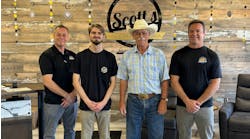When Benline purchased Robert’s Auto Service from then-owner Bill Clum in 2003, he continued the industry-standard approach of not providing customers pricing over the phone. This left customers with two options: trust the voice on the other end of the line and proceed with the repair, or hang up, grab the Yellow Pages, and start the process anew.
Then came the World Wide Web.
While search engines existed in 2003, predominantly as a tool for indexing websites and information, those primitive websites didn’t put the power of information and global pricing transparency into the hands of consumers at the level seen today. For modern shops, not being forthcoming about price first could be a kiss of death.
“You can't compete with the information that’s in people's hands,” Benline says of consumers with smartphones. “[It’s] very hard … to educate your customer when the Internet's educating them. I fought it for years, and realized the more I fought it, the more it didn't seem to work in a positive direction. It seemed like customers felt like I was trying to sell them something as opposed to helping them.”
Rather than fight his customers on whether the cost of the repair at his shop or the pricing of his parts was higher than others in the marketplace, Benline decided to turn consumer technology into an advantage for his shop.
Here’s what he did.
Eliminate Price Comparison
Benline says while shops provide a service, one commodity every shop provides is parts. Realizing customers would hop onto Amazon to get pricing front and center, and do the same through the websites of auto parts suppliers such as O’Reilly, NAPA, Autozone, and Advance Auto Parts, he decided to give customers what they wanted—similar pricing as online retailers.
“Rather than trying to make big parts profit and fight customers [who are searching] the internet—although we have warranties, yes—I decided to lower my parts profit and make it up in labor,” he says.
He took it a step further by placing a widget on his website that allows customers to see pricing information for various types of repairs based on their vehicle.
“I just found that the more open you are, the more communicative you are, it seems the public trusts you more and works with you more,” Benline says.
Profit from Fee-Based Services
Benline uses a number of online services to acquire new customers, one being RepairPal. Since digital-savvy customers use the website to find shops and to get ballpark repair estimates on their vehicles, he’s learned to see the money spent in with the provider as an investment. One aspect he’s benefitted from is RepairPal’s towing service through partner provider Honk.
“When RepairPal gives you tow in, they charge you 10 percent. I’ll do that because if I meet that customer through RepairPal once, and he's got other cars, I have a chance to get those other cars and all the referral business from them if I do a good job,” he says.
One time, Benline received a $1,200 bill from the service. He considered fighting it and canceling the service. After thinking it through, Benline asked himself what a customer would do. Would they pay to be towed to his shop, or use the provider’s free tow to an in-network shop? His decision was made.
“If I put myself in the customer's shoes, I might take the chance and go with [another] repair shop instead of Robert’s Auto Service with Keith because I want to take advantage of the [free] towing,” he says.
Stay In Front of Customers
Benline has no problem paying for internet-based services customers use regularly because it stretches his marketing dollar. His goal is to be where the customers are, use the service providers they prefer, and provide the services they want.
“These programs … they don't cost much, a couple hundred bucks and you get a good platform from them. With RepairPal, they'll charge 10 percent, but still, your return on investment is just phenomenal,” he says.
Benline says shop owners would benefit by being easy to work with, accessible through service providers, and active on consumer-driven platforms when it makes sense.
“There’s no silver bullet. Openbay costs me $150 to $200. RepairPal is the same. I spend $600 with Yelp. I do a direct mail piece and spend $250 a week and focus on 5,000 to 6,000 targeted pieces. It’s not that much money. And I use Mitchell 1 customer retention management program and comment on and share the reviews I get,” Benline says.
But whatever you do, don’t fight the internet—its undefeated.




